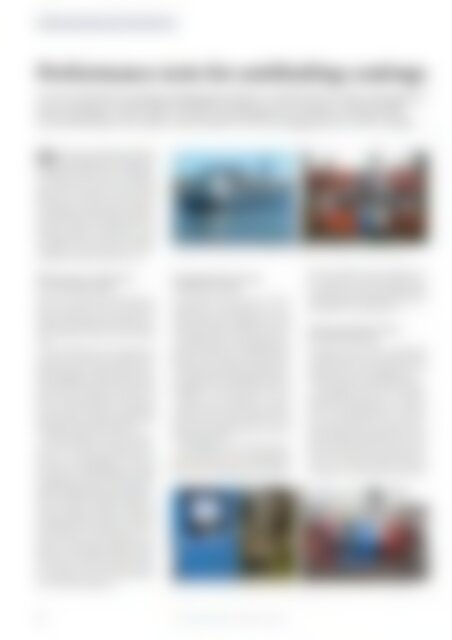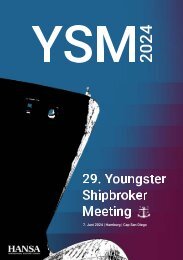HANSA 05-2019
Nor-Shipping ’19 | Maritime Hub Norway | Finanzplatz Oslo | Tugs & Salvage | HullPIC | Offshore-Logistik | NordLB | Breakbulk Europe | Hansa Heavy Lift | HS Schiffahrt | MPP-Carrier
Nor-Shipping ’19 | Maritime Hub Norway | Finanzplatz Oslo | Tugs & Salvage | HullPIC | Offshore-Logistik | NordLB | Breakbulk Europe | Hansa Heavy Lift | HS Schiffahrt | MPP-Carrier
Create successful ePaper yourself
Turn your PDF publications into a flip-book with our unique Google optimized e-Paper software.
Schiffstechnik | Ship Technology<br />
Performance tests for antifouling coatings<br />
Current performance testing of antifouling products is mainly based on static raft exposure<br />
tests (according to ASTM D3623/ D6990) or polishing tests in seawater (ASTM D4938).<br />
Such methods give only indirect measurement of friction drag properties of hull coatings<br />
Major function of antifouling coatings<br />
is to keep added friction drag due to<br />
biofouling accumulation on a ship hull at<br />
a minimum. There are three test methods<br />
that do give direct data on friction drag<br />
properties of coatings (with and without<br />
fouling) and as such can be used in product<br />
comparison and selection of suitable<br />
products. Whereas for registration of antifouling<br />
products manufacturers need<br />
to provide efficacy data from (simulated)<br />
field tests, a short description of this<br />
standardised method is given as well.<br />
Efficacy tests for registration<br />
of antifouling products<br />
Endures has long lasting experience in<br />
static raft exposure tests of antifouling<br />
paints. These tests are carried out according<br />
to the BPR Guidance Document<br />
Vol. II – Efficacy (version 3, ECHA, April<br />
2018).<br />
As an independent contract laboratory<br />
Endures can make direct comparison of<br />
the performance of paint products from<br />
different suppliers under the same exposure<br />
conditions. Our exposure site in the<br />
harbour of Den Helder, the major naval<br />
base in The Netherlands, is representative<br />
for North Sea coastal water with high<br />
fouling pressure during a fouling season<br />
lasting from March till November.<br />
Seawater parameters such as temperature,<br />
pH, salinity and oxygen concentration<br />
are continuously monitored at<br />
the lab. The methodology to evaluate<br />
the efficacy of antifouling paints is based<br />
on methods described in ASTM D3623/<br />
D6990. Regular inspections and photographs<br />
are made during the fouling season,<br />
percentage coverage of fouling on<br />
panels is estimated and from these data<br />
a Fouling Resistance (FR) rate is derived:<br />
FR 100 means no fouling and with F 0 a<br />
panel is fully covered. Product performance<br />
is evaluated on pass/fail criteria<br />
described in the BPR Guidance document.<br />
This test will only show the ability<br />
of a coating to resist or prevent the settlement<br />
of fouling organisms.<br />
Endures raft in the harbour of Den Helder and raft exposure rack with different hull coatings<br />
Drag performance testing<br />
of ship hull coatings<br />
The principle of this test is to carry out<br />
comparative measurements of friction<br />
resistance of coated disks with and<br />
without fouling. In addition to static<br />
raft exposure tests this test gives relevant<br />
information on fouling adherence<br />
and release properties of hull coatings.<br />
This test is carried out with the Friction<br />
Disk Machine available at the laboratory.<br />
Paints under investigation need to<br />
be applied on circular disks. The coated<br />
disks are first measured in clean<br />
condition, then exposed for a specific<br />
time period in the harbour of Den<br />
Helder where they get fouled and then<br />
retrieved to the laboratory for a second<br />
drag measurement.<br />
The difference in friction drag between<br />
fouled and clean condition gives<br />
quantitative data on the drag penalty<br />
that a certain fouling pattern may give.<br />
This way different paint products can<br />
be compared on friction drag properties.<br />
The test method is suitable for both<br />
self-polishing paints (SPC) as well as for<br />
fouling release coatings (FRC).<br />
Minimal speed foul release<br />
test for hull coatings<br />
The purpose of this test is to establish the<br />
minimal speed for self-cleaning of hull<br />
coatings with marine fouling. The test<br />
protocol involves two different steps:<br />
Static exposure of coated panels to marine<br />
fouling for periods of 1 – 4 months,<br />
followed by rotating drum testing in seawater<br />
at increasing speed (4 – 30 knots)<br />
for several rotation times. After static exposure<br />
the panels are inspected on fouling<br />
condition, mounted onto the rotor<br />
drum and subjected to a rotation protocol<br />
with incremental speed steps of two<br />
knots up to the speed where all fouling<br />
is removed. At each speed several rota-<br />
Friction Disk machine for drag measurements on coated disks with and without marine fouling<br />
© Endures<br />
52 <strong>HANSA</strong> International Maritime Journal <strong>05</strong> | <strong>2019</strong>


















